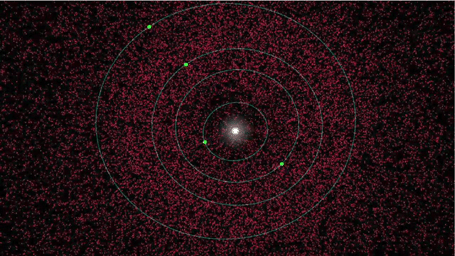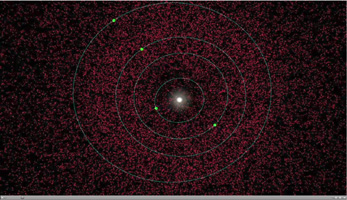
|
Changing Views of Our Solar System
- Click the image above for a larger view
 Movie Download Options
Movie Download Options- Full-Res JPEG (1281 x 720) (233.1 kB)
- Full-Res TIFF (1281 x 720) (2.8 MB)
Caption:

Click on the image for the animation
This animation illustrates new results from NASA's Wide-field Infrared Survey Explorer, or WISE, taken during its one-year survey of the sky in infrared light. The asteroid-hunting portion of the mission, called NEOWISE, scanned for asteroids both in the main belt between Mars and Jupiter, and those near Earth. The observations led to a reduced estimate of the total population of medium to large-sized near-Earth asteroids (objects larger than 330 feet or 100 meters).
The movie begins by showing a simulated view of the estimated population before the NEOWISE survey, depicted in red. Each dot represents one asteroid. Object sizes are not to scale. At that time, the best models for the entire population, based on visible-light surveys, indicated roughly 36,000 members.
The movie then reveals known asteroids in orange. About 5,200 near-Earth asteroids larger than 330 feet have already been discovered. Next, the blue dots show which asteroids NEOWISE observed, and the white dots are those the project discovered. The NEOWISE telescope observed more than 500 of these space rocks, including the newfound ones.
The animation also illustrates how NEOWISE was able to capture a slice of the near-Earth asteroid population. The telescope orbited the poles of Earth, continuously taking snapshots of the sky at 90-degree angles from the sun. As Earth orbited around the sun, WISE detected more and more near-Earth asteroids. It also saw more than 150,000 asteroids in the main belt between Mars and Jupiter, which are not shown here.
From these data, the science team was able to make the most accurate estimates to date of what the entire near-Earth asteroid population looks like. The next part of the movie shows what the mission found -- fewer total numbers. The NEOWISE observations indicate that there are about 20,500 near-Earth asteroids in total that are larger than 330 feet -- 43 percent less than previous estimates of 36,000.
Background Info:
JPL manages the Wide-field Infrared Survey Explorer for NASA's Science Mission Directorate, Washington. The principal investigator, Edward Wright, is at UCLA. The mission was competitively selected under NASA's Explorers Program managed by the Goddard Space Flight Center, Greenbelt, Md. The science instrument was built by the Space Dynamics Laboratory, Logan, Utah, and the spacecraft was built by Ball Aerospace & Technologies Corp., Boulder, Colo. Science operations and data processing take place at the Infrared Processing and Analysis Center at the California Institute of Technology in Pasadena. Caltech manages JPL for NASA.
More information is online at http://www.nasa.gov/wise and http://wise.astro.ucla.edu .
Cataloging Keywords:
| Name | Value | Additional Values |
|---|---|---|
| Target | 4 Vesta | |
| System | Main Belt | Near Earth Objects |
| Target Type | Asteroid | |
| Mission | Near-Earth Object Wide-field Infrared Survey Explorer (NEOWISE) | |
| Instrument Host | NEOWISE | |
| Host Type | Space Telescope | |
| Instrument | NEOWISE Telescope | |
| Detector | ||
| Extra Keywords | Color, Infrared, Movie | |
| Acquisition Date | ||
| Release Date | 2011-09-29 | |
| Date in Caption | ||
| Image Credit | NASA/JPL-Caltech | |
| Source | photojournal.jpl.nasa.gov/catalog/PIA14735 | |
| Identifier | PIA14735 | |
